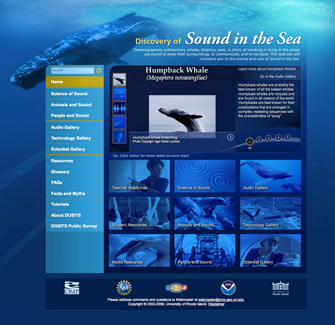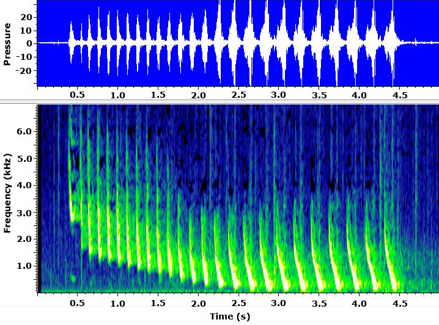Discovery of Sound in the Sea On-line Resources
Kathleen J. Vigness-Raposa - kathleen.vigness@marineacoustics.com
Marine
Acoustics, Inc.
Gail
Scowcroft - gailscow@gso.uri.edu
Christopher
Knowlton - cknowlton@gso.uri.edu
Holly
Morin - hmorin@gso.uri.edu
Office
of Marine Programs
Popular
version of paper 3pAB10
Presented
Wednesday afternoon, April 21, 2010
159th
ASA Meeting,
Oceanographers,
submariners, whales, dolphins, and seals -- all working or living in the ocean --
use underwater sound to sense their surroundings, to communicate, and to
navigate. The scientific community and the public have become increasingly
aware of, and concerned about, underwater sound. There is interest in learning
about the sources and uses of sound, and the potential effects of sound on the
environment. Underlying this interest, however, is a need to provide scientific
information at a level appropriate for the general public and for educational
and media professionals. The Discovery of Sound in the Sea website (http://www.dosits.org) provides
scientific content introducing the physical science of underwater sound and how
people and animals use sound to accomplish various tasks. We are excited to
announce the launch of a significantly redesigned website that takes advantage
of the advances in web technology since the website was originally launched in
November 2002. The look and feel of the website has been refreshed without
losing functionality or content. The redesigned DOSITS site offers a much more
interactive learning environment. The front page uses a Flash-based interactive
that allow users to quickly immerse themselves in exciting content, from the songs
of humpback whales to interviews with cutting-edge scientists to the science
used to measure waves.

Figure 1. Front page of
the Discovery of Sound in the Sea website (http://www.dosits.org)
Interactives
have also been created for the Audio Gallery and the Scientist Gallery, two
areas with an extraordinary amount of multimedia resources. The Audio Gallery
includes over 65 examples of sound sources found in the oceans, from the unique
underwater sounds of a lightning strike or ice cracking to the haunting sounds
of the Weddell seal.

Figure 2.
Visualization of a Weddell Seal call from the DOSITS Audio Gallery.
Each
Audio Gallery page includes images and sounds of the highlighted sound source,
as well as descriptive material to inform the reader. We are continuously
working with researchers to expand the Audio Gallery and have recently added
underwater video clips to several Audio Gallery pages. The Scientist Gallery
includes in-depth interviews of five scientists conducting cutting-edge
acoustics research. The interactive allows the user to select a scientist by
name or their research field. The interviews can be viewed as videos and
transcripts of the interviews can be seen simultaneously while watching the
videos or downloaded to read later. There are also images of their research and
a brief summary of their recent results.
In
addition to the scientific content and specialty galleries, the DOSITS website
also includes three major resource sections. The Media Resources include a
Facts & Myths quiz, Frequently Asked Questions, and a backgrounder on how
animals hear under water. In addition, PDF reprints of a tri-fold pamphlet and
a 12-page educational brochure are available. The 12-page booklet specifically
addresses stakeholders questions regarding sound in the oceans. Background
scientific content written for the lay person and highlighted issues related to
the use of sound in the sea by animals and humans provides the reader with a
clear picture of what is currently understood about this important topic. The
booklet text relies exclusively on peer-reviewed literature and has also been
reviewed by the DOSITS external scientific advisory team. Over 3,000 booklets
have been distributed since publication, including distribution to the United
States Senate and House of Representatives. In addition, a tri-fold brochure
has been published that highlights the content on the DOSITS web site and
promotes its use. Over 5,000 of these have also been distributed. These
resources are specifically targeted for media individuals, providing clear,
concise descriptions of the most interesting aspects of underwater sound. The
Teacher and Student Resources include structured tutorials and educational
games. DOSITS provides easy, efficient access to timely information on the
science of underwater sound and the current state of knowledge of the effects
of underwater sound on marine mammals and fishes.
Since
its original launch in November 2002, DOSITS has experienced tremendous
popularity. During 2009, DOSITS recorded more than 6.4 million hits; this is an
extraordinary amount for an educational website. The February to May time
period is typically strong for DOSITS due to wide exposure at meetings and
workshops for K-12 teachers in the

Figure 3. Bar chart of
monthly hits on DOSITS from 2003 to 2009.
Funded
by the